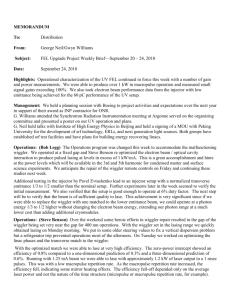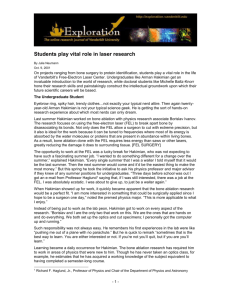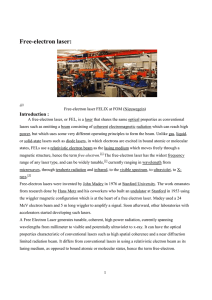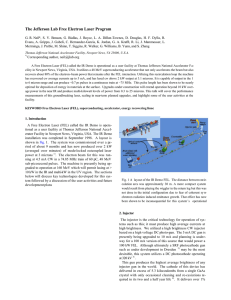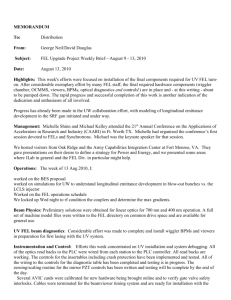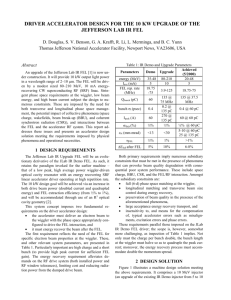How the free-electron laser works
advertisement
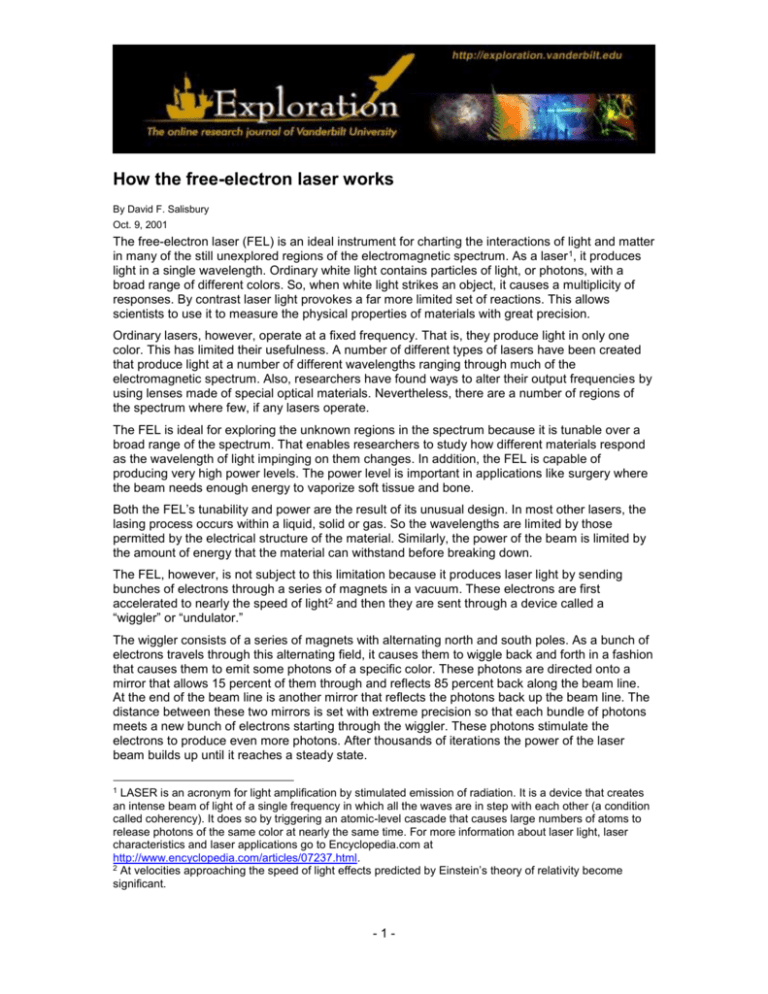
How the free-electron laser works By David F. Salisbury Oct. 9, 2001 The free-electron laser (FEL) is an ideal instrument for charting the interactions of light and matter in many of the still unexplored regions of the electromagnetic spectrum. As a laser 1, it produces light in a single wavelength. Ordinary white light contains particles of light, or photons, with a broad range of different colors. So, when white light strikes an object, it causes a multiplicity of responses. By contrast laser light provokes a far more limited set of reactions. This allows scientists to use it to measure the physical properties of materials with great precision. Ordinary lasers, however, operate at a fixed frequency. That is, they produce light in only one color. This has limited their usefulness. A number of different types of lasers have been created that produce light at a number of different wavelengths ranging through much of the electromagnetic spectrum. Also, researchers have found ways to alter their output frequencies by using lenses made of special optical materials. Nevertheless, there are a number of regions of the spectrum where few, if any lasers operate. The FEL is ideal for exploring the unknown regions in the spectrum because it is tunable over a broad range of the spectrum. That enables researchers to study how different materials respond as the wavelength of light impinging on them changes. In addition, the FEL is capable of producing very high power levels. The power level is important in applications like surgery where the beam needs enough energy to vaporize soft tissue and bone. Both the FEL’s tunability and power are the result of its unusual design. In most other lasers, the lasing process occurs within a liquid, solid or gas. So the wavelengths are limited by those permitted by the electrical structure of the material. Similarly, the power of the beam is limited by the amount of energy that the material can withstand before breaking down. The FEL, however, is not subject to this limitation because it produces laser light by sending bunches of electrons through a series of magnets in a vacuum. These electrons are first accelerated to nearly the speed of light2 and then they are sent through a device called a “wiggler” or “undulator.” The wiggler consists of a series of magnets with alternating north and south poles. As a bunch of electrons travels through this alternating field, it causes them to wiggle back and forth in a fashion that causes them to emit some photons of a specific color. These photons are directed onto a mirror that allows 15 percent of them through and reflects 85 percent back along the beam line. At the end of the beam line is another mirror that reflects the photons back up the beam line. The distance between these two mirrors is set with extreme precision so that each bundle of photons meets a new bunch of electrons starting through the wiggler. These photons stimulate the electrons to produce even more photons. After thousands of iterations the power of the laser beam builds up until it reaches a steady state. 1 LASER is an acronym for light amplification by stimulated emission of radiation. It is a device that creates an intense beam of light of a single frequency in which all the waves are in step with each other (a condition called coherency). It does so by triggering an atomic-level cascade that causes large numbers of atoms to release photons of the same color at nearly the same time. For more information about laser light, laser characteristics and laser applications go to Encyclopedia.com at http://www.encyclopedia.com/articles/07237.html. 2 At velocities approaching the speed of light effects predicted by Einstein’s theory of relativity become significant. -1- How the free-electron laser works The color of the laser beam can be varied in two ways: putting more power into the electron beam and changing the spacing between the magnets in the wiggler. The Vanderbilt FEL is designed to operate at infrared frequencies and can be tuned from two to nine microns. Because the production of laser light occurs in a vacuum, an FEL can be designed to operate at extremely high power levels. The Vanderbilt FEL is designed to produce a beam with a peak power of more than 10 Megawatts and an average power of 10 Watts. Lasers come in two basic types: continuous and pulsed. One produces a continuous beam of light and other produces light in pulses. The Vanderbilt FEL is a pulsed laser. Its beam consists of a series of extremely short pulses, each lasting less than a billionth of a second. - VU - -2-





